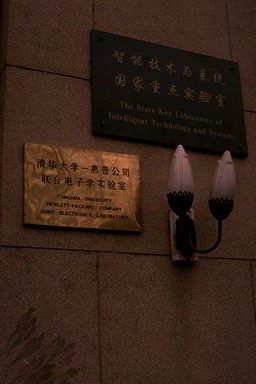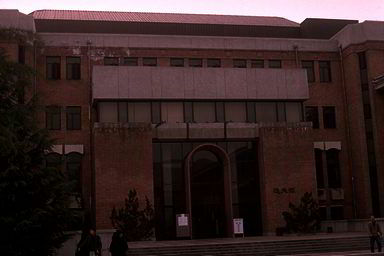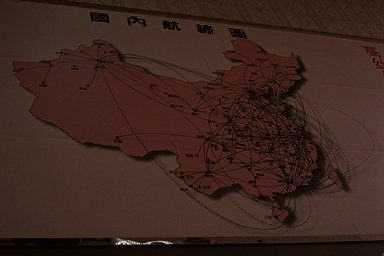
Signs

Library

Flowers

Map

Rural Asia

This report describes a technical visit to five higher educational institutions during March 22 through April 4 1998. In that time I gave five formal presentations on Image Complexity and Image Pattern Recognition, met forty individuals and visited several laboratories. Four of the labs had special national status as key state laboratories. The subjects discussed were Image Processing and Pattern Recognition (IPPR), Pattern Recognition (PR), Automatic Control (AC), Automation (A), Computer Aided Design (CAD), Computer Graphics (CG), Industrial Process Control (IPC), Artificial Intelligence (AI), Human Computer Interaction (HCI), Coding (C), and Software Development Environment (SDE). The universities, their locations, and brief notes about each follow in the order of the visits.
Universities.
Shanghai Jiao Tong University, Shanghai CHINA 200030
Shanghai Jiao Tong University was founded during the Chin dynasty. (The Jiao Tong in the university name means "transportation".) It is one of ten elite Chinese universities. There are 12 schools in the university. The basic IPPR training is in Automatic Control. The old campus has 2000 undergraduate students, 500 master's degree, and 300 Ph.D. My visit was entirely to the old campus. This campus was in the city within an enclosed park-like region. It felt something like an American Ivy League college. Departments of languages have moved entirely to the new campus, which admits 3000 undergraduates annually, hence has a total of 10-12,000 students.
Zhejiang University, Hangzhou CHINA 310027
This university was also founded during Chin dynasty (about 1896). The current campus dates from the post-liberation era (Chinese term for post World War II victory of Communists over Nationalists). It is based on Russian adaptations of the American land-grant university campus concept. There is an older campus (which I did not see) in the city center. Teaching supports training select students in a special science-oriented curriculum. Both state key laboratories (CAD and CG, IPC) are connected with university-owned commercial companies. These companies provide a substantial part of the university operating budget.
Tsinghua University, Beijing CHINA 100084
This university became a scientific rather than a general institution following the liberation. It is the most prestigious scientific university in China. The campus is large and picturesque, with old and modern buildings, including a contemporary library with extensive computer services open to the individual students. It is located in the region near the Summer Palace, an attraction noted for its beauty. There are two state key laboratories, one on AI, the other on PR and A. The former is officially titled Intelligent Technology and Systems. It was by far the most extensive key laboratory I visited. It is run as an open laboratory in that other Tsinghua students and researchers can use it.
Central University for Nationalities, Beijing CHINA 100081
The leading school of eighteen national universities serving 100,000,000 people, 8% of China's population (homelands comprise 64% of the country's area). Dean visited Stanford, spoke at UN.
Beijing University of Aeronautics and Astronautics,Beijing CHINA 100083
Ranked fifth among Chinese universities. Close to "Chinese Silicon Valley." My impression is that they have the largest faculty in computing of all these universities. Two professors have been to the U.S. for over six months (one for several years). Has a key national laboratory in SDE that debugged Lotus Notes and has a continuing relationship with IBM. This is an open laboratory.
 Signs |
 Library |
 Flowers |
 Map |
 Rural Asia |
 Modern Shanghai |
Central University for Nationalities, Beijing CHINA 100081
Beijing University of Aeronautics and Astronautics, Beijing CHINA 100083
Ranked fifth among Chinese universities. Close to "Chinese Silicon Valley." My impression is that they have the largest faculty in computing of all these universities. Two professors have been to the U.S. for over six months (one for several years). Has a key national laboratory in SDE that debugged Lotus Notes and has a continuing relationship with IBM. This is an open
laboratory. Has a museum of aircraft that includes one of two existing US WWII Black Widow fighters.
Technology
In China university work is closely coupled to societal needs. This is evident both in a range of projects, and the existence of parallel organizations (commercial entities) to key national laboratories.
Shanghai Jiao Tong University
Key Personnel: Professor Li, Jie-gu; and Professor Shi, Peng-Fei, Director Institute of IPPR
Electronic Mail: Li, Jie-gu <fcsjtu@online.sh.cn>; Shi, Peng-Fei <pfshi@ippr.sjtu.edu.cn>
Students and projects of Prof. Li, Jie-gu
Demonstrated recognition software that is able to locate currency notes: Chinese, Hong Kong and U.S. dollars;alone or against a background (includes a fan of many bills). Results in black image in place of note. This demonstration was on a Pentium-based Chinese PC clone. The software is used to prevent color-xerox counterfeiting. The government requires placement of a chip based on this software in all copiers in the PRC.
Demonstrated Voronoi Graph matching of line drawings extracted from airborne images tosections of similar satellite-derived data. This demonstration was on a Silicon Graphics computer.
Zhejiang University
Key Personnel: Professor Jin, Xiao Gang, State Key Lab of CAD and CG and Artsea Computer Graphics Company; and Rong, Gang, Institute of IPC
Electronic Mail: Jin, Xiao-Gang <zucad@public.hz.zj.cn>; Rong, Gang <grong@iipc.zju.edu.cn>
Students and projects of Prof. Jin, Xiao Gang
Work in Scientific Visualization, Animation, Rapid Rendering on Silicon Graphics computers. Received an award of $ 1,000,000 in 1998 which will be used to purchase Sun computers.
Has software able to run 17 minutes on a 486-based PC to render reflections on over 64,000 spheres in a fractal image.
Has a project to animate the Xian ceramic warriors.
Working on Computerized Tomography, Magnetic Resonance Images to create oct-tree based solid models.
Students and projects of Prof. Rong, Gang
The Institute of IPC has a great deal of older Digital Equipment Company computer equipment. The parallel university-owned company has 30% of China's market for distributed controls.
Locate People in Chinese Universities